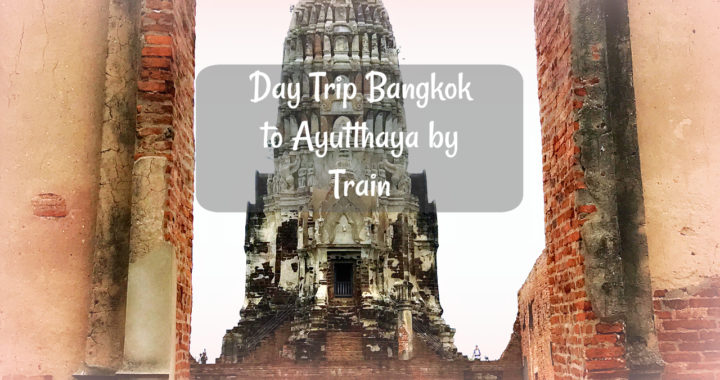Historic City of Ayutthaya
Dating back as far as 1351, the historic city of Ayutthaya was the second capital of the Siamese Kingdom.
Situated approximately 80km north of Bangkok, Ayutthaya was strategically built on an island 4km wide and surrounded by 3 rivers connecting the city to the sea.
In its heyday it was endowed with temples and surrounded by a 12km long wall. The city was attacked and burnt to the ground by the Burmese army in 1767 and forced the residents to leave the city. It was never rebuilt in the same location and the remains are now an extensive archaeological site.
There is plenty of information on the history of this area so this blog is not going to become just another Wikipedia site but rather how we visited this city in a day from Bangkok.
How to Get There from Bangkok
There are a variety options on how to get to Ayutthaya from Bangkok. You can arrive by bus, minivan, boat, car, motorbike or train.
You can do a lot of research on what mode of transport is best for you depending on your start point and how much time you have.
We chose the train as it was easy and it’s all about the journey, not just the destination for us.
How To Catch the Train
All trains leaving Bangkok for Northern Thailand leave from the Hua Lamphong Station. This is a very busy station which can be reached via the MRT.
We caught the MRT to Bang Sue as this saves around 20 min rather than starting at Hua Lamphong and meant that we weren’t double backing.
The Bangkok to Ayutthaya train leaves very regularly so there really is no need to rush, however we do recommend that you get an early start, especially if you are intending to visit Ayutthaya for a day trip.
We arrived at Bang Sue at around 7.30am, found the train station easily from the MRT and brought the tickets for the next departing train. Now the trains travelling to Chang Mai and all destinations along this northern line stop at Ayutthaya and they will sell you tickets for the next available train.
Third Class is Not So Bad
Our tickets cost 20THB ($0.80nz) each one way and this was on 3rd class transport. The ticket seller spoke reasonable English and was able to tell us when the train was due and from what platform – easy!
Now I’m always a little apprehensive when I hear the words ‘3rd class’ anywhere in SE Asia. Not that I am a travel snob and Lord knows, I’ve had to become accustom to ‘roughing it’ a little more than we used to when travelling. As we were standing on the platform, I’m telling myself ‘it will okay, it’s only 1 hr 15 min of discomfort,’ how bad can it be?
I was pleasantly surprised and it was definitely manageable. We had padded seats (I had read that there were carriages where the seats were wooden), no air con but rather windows that opened. I found this to be brilliant. I can remember as a kid (having a father who was train mad) travelling on trains with windows that opened. There is something about having the wind in your hair, leaning out (without getting beheaded) which takes rail travel to a whole different level. With all the safety issues surrounding this type of travel in the western worlds, means that train travel is usually undertaken in fully air con carriages with plush seats, piped music, tables, footrests and dining carriages.
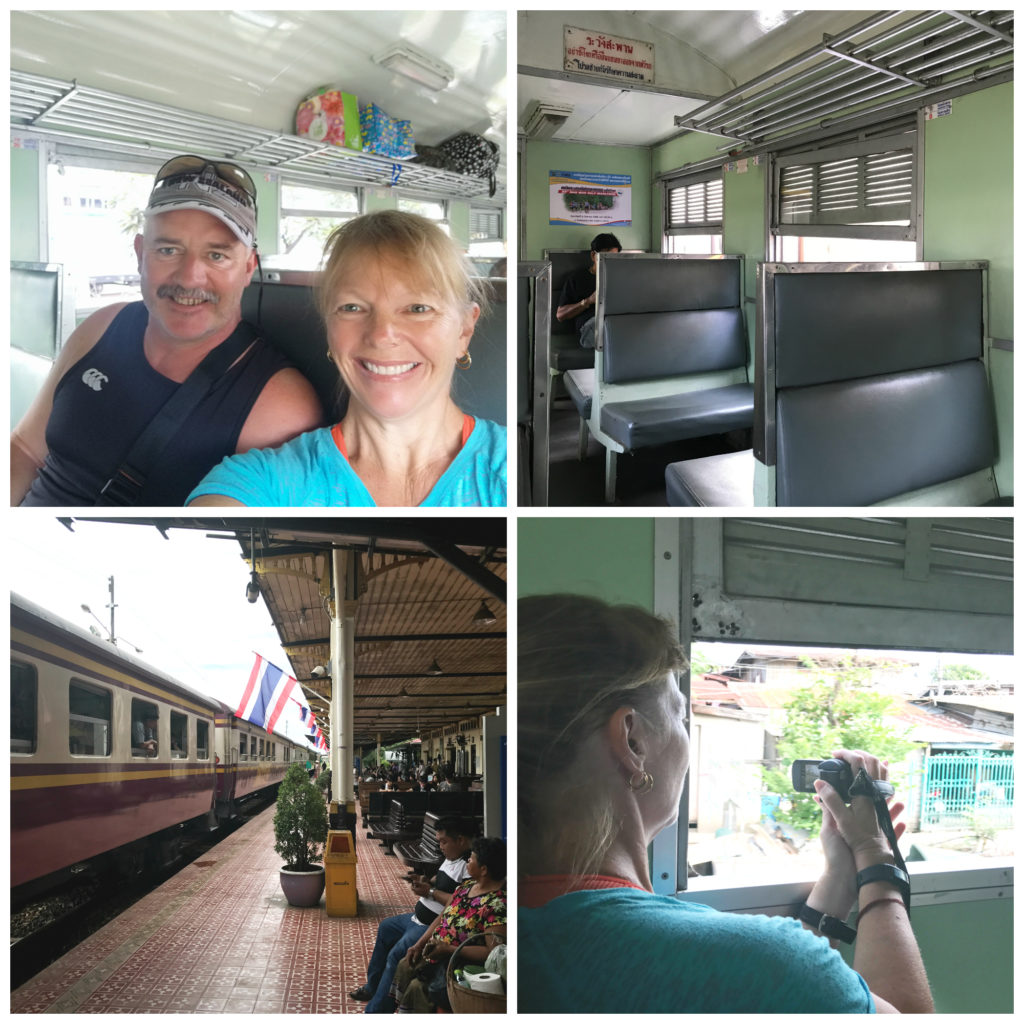
Just love open window train travel
Well while we had none of the above, our trip was very enjoyable, sitting back taking in the scenery whizzing by – even though the wind in our faces felt like we were sitting in front of a blow dryer on full heat!
Every few minutes, we had food vendors walking the isles selling fresh fruit, rice dishes, sweets and drinks so there was something for everyone who felt the need to eat. We had eaten breakfast beforehand and I really didn’t want to have to use the toilet facilities on board. I have experienced train toilets before in Thailand and it really isn’t an experience you wish to repeat too often unless you really, really have to.
The time of the morning meant that the train was not overly full and very few tourists on board. With 3rd class, there are no seat numbers assigned so if you intend travelling during busier times, just bear in mind that you may end up standing for the duration of the trip.
For more details on options and train timetables click on the link to take you to Man in Seat 61. A great source of information on any train travel in SE Asia and beyond.
So You’ve Arrived at Ayutthaya – What Now?
As I’ve mention earlier, the main attractions of Ayutthaya are located on an island called Ko Muang so first you need to get yourself over there.
This is also easy. Just start wandering down a side road directly opposite the train station and you will come across the little ferry which transports people to and from the island (just a few minutes on the water and you are there).
Just a tip – if you are wanting to rent a bicycle, wait until you are on the island side. This will save you hassle of trying to load it onto the ferry and you also have to pay extra for the bike on the ferry.
The ferry only cost us 5THB (0.20nz) each one way and is constantly running back and forth.
We hired our bikes from December House which is just a short walk from the ferry landing (located on the LHS). She was so good to deal with, spoke very good English and her bikes were in great condition. Scotty opted for a mountain bike but once again I got the ‘nana’ bike with a basket for our water bottles and day pack. She offered us some advise on the route to take, gave us a map and numbered the locations so that we knew which sites to visit and in what order to do them. She also recommended some good eating spots (which is always important).
The bike rental cost us 80THB ($3nz) for Scotty’s mountain bike and 50THB ($2nz) for my nana bike.
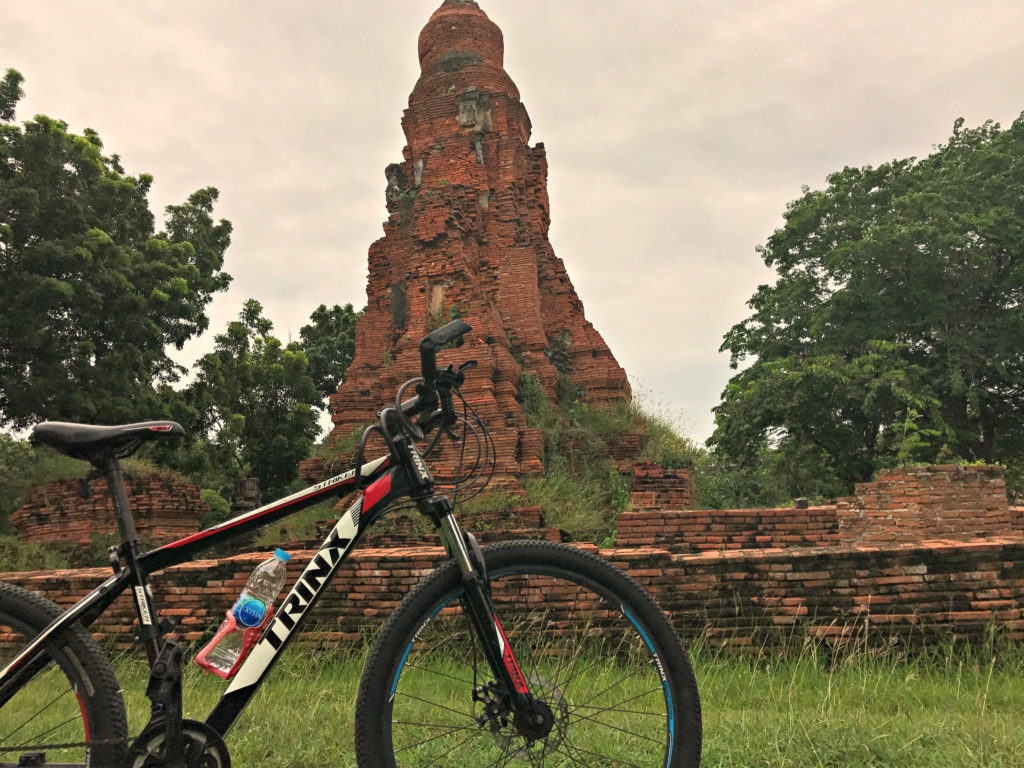
Cycling the best option for us
They also offer accommodation and judging from the service she gave us and the décor from what we could see, we think that it would be a good option if you were wanting to stay and night or two.
You do need to have good road sense as a grid of broad roads crosses the island but outside the small town, the roads are less congested and ideal for exploring by bicycle. However, in saying that it may not be suitable for young children on bikes.
What is There to See
As previously mentioned, the Burmese captured and ravaged Ayutthaya, taking tens of thousands of prisoners back to Burma and left the wats in ruins.
Ayutthaya was listed as a World Heritage Site by UNESCO in December 1991.
The majority of Ayutthaya’s ancient remains are spread out across the western half of the island.
The city’s main temples can be visited for a reduced rate if you purchase a special six-in-one pass which is available from most temple ticket offices.
Now you may be an avid temple (wat) junkie and soak up everything which could possibly take you an entire day or even more but we were mindful that we were only day trippers, the day was getting hotter by the hour and most sites were starting to full up with van loads of tourists.
Although we love temples and history sometimes saturation point is reached, especially taking into account the above factors. There is an option to ‘pay as you go’ which was only 50THB ($2nz) each per site. We paid to go into two sites which were the main attractions. There are also wats that you can wander around for free or you can get a view of some of the sites by just cycling past.
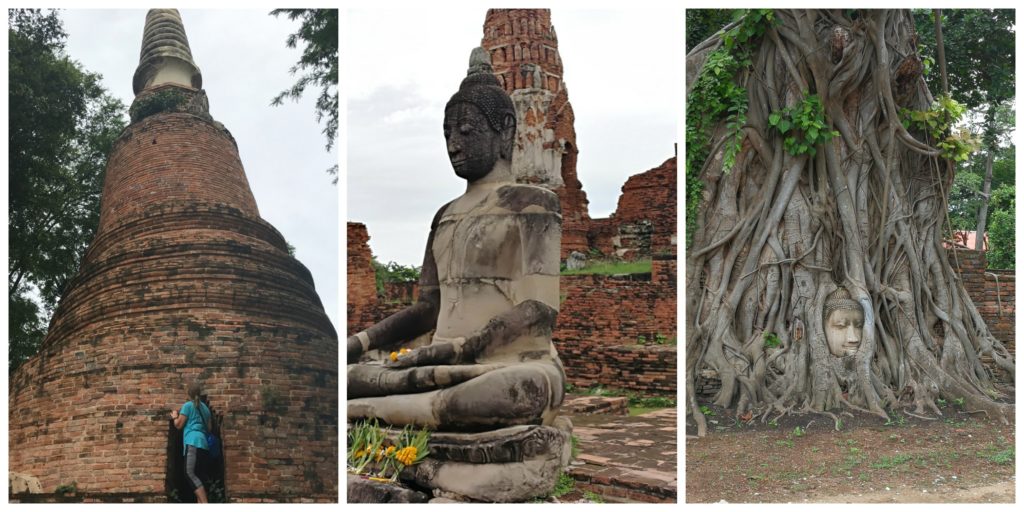
So many places to explore in the Historical Park
We thoroughly enjoyed walking around the ruins of the old city within the Ayutthaya Historical Park. The ruins, the prang (towers) and the huge monasteries, give you an idea of the city’s past splendor.
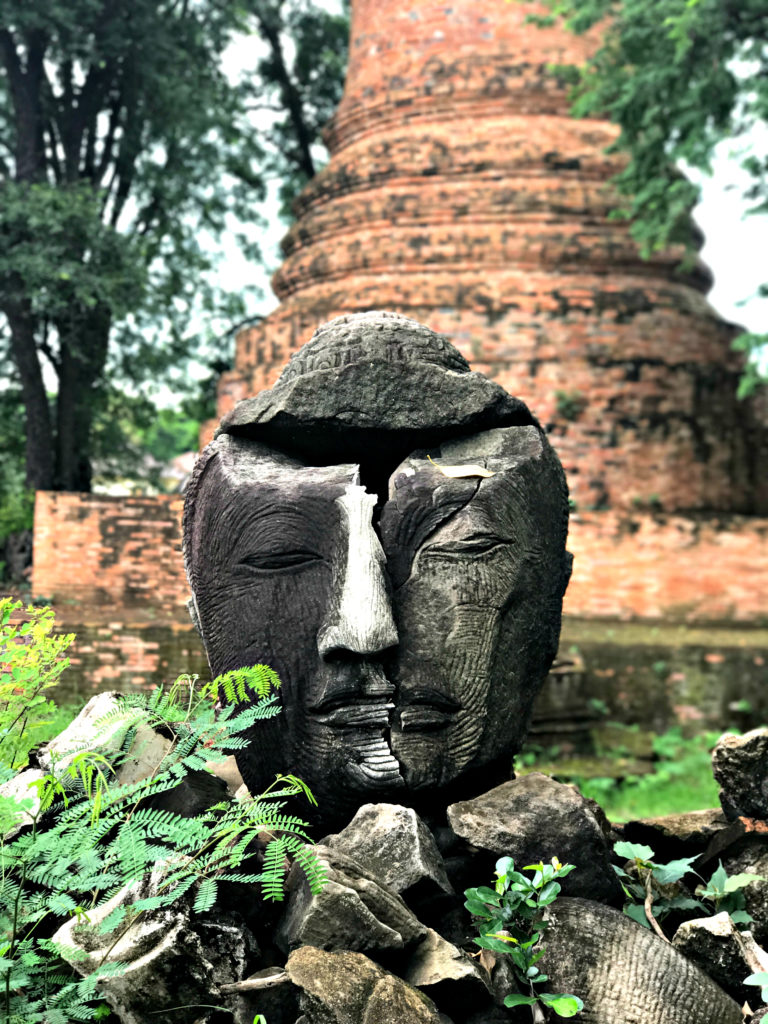
a great place for photo opportunities
What’s for Lunch
After our early start combined with cycling around and exploring the historic sites meant that we were searching for our lunch stop by midday.
Because of Ayutthaya’s multi cultural past, there is an array of signature specialties. One of these is know as kuay tiao ruea, or commonly know as boat noodles. Back in the day, Chinese vendors plied the many canals selling bowls of rice noodles in pork broth from the comfort of their wooden sampans (long, narrow rowboats).
You can still find examples of these boats but they’re propped up and used as counter space at the boat noodle shops found all over the town.
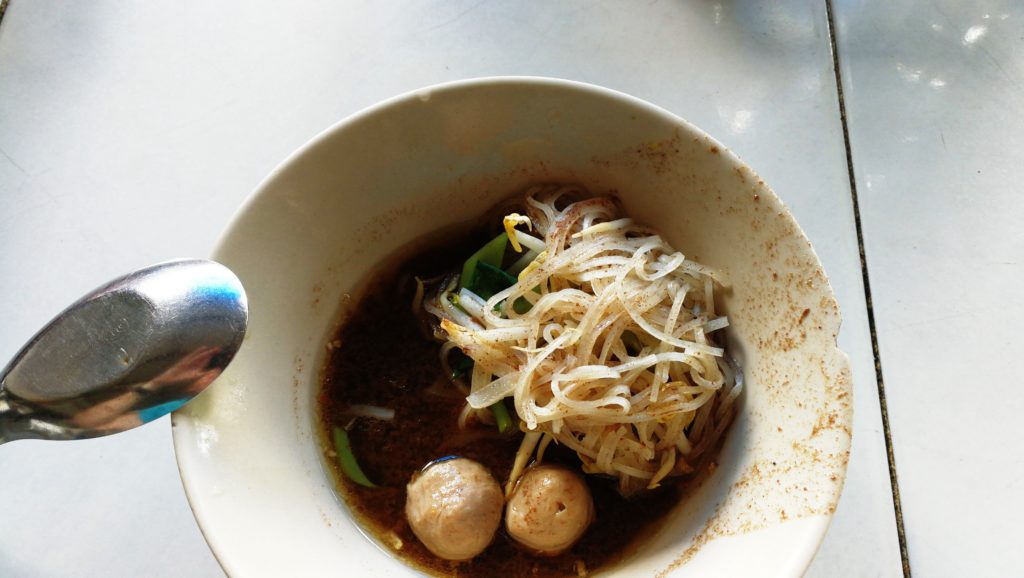
traditional beef boat noodles
We sat down at one of the recommended eateries (packed with locals which is always a good sign) and tucked into a bowl of beef boat noodles for 15THB ($0.60nz) each.
Time For Home
There were a lot more historic sites we could have visited but the heat of the day had kicked in as well as the tourists so by 1.30pm, we thought that it was time for home. This also meant that we would back in Bangkok before the rush hour started on the MRT (this seems to kick in from 3pm onwards).
Sorting out the train transport for the way home was relatively easy and once again, the train service is regular but not quite a frequent as the morning services.
The train station was definitely busier than the morning as there were a lot of travellers continuing their journey to or from Chang Mai in the north. Stopping off at Ayutthaya enroute to Chang Mai is a popular option and many travel sites recommend that you stay either one or two nights here. This would certainly give you more options to explore the historical sites outside the parameters of the island and also view the ruins at night which are all illuminated by up-lights which I imagine would be quite a sight to see.
We were quite happy with the amount of time we spent there and very pleased that we made the trip north to see Ayutthaya.
Click on the link below to see a ‘highlights’ video.
